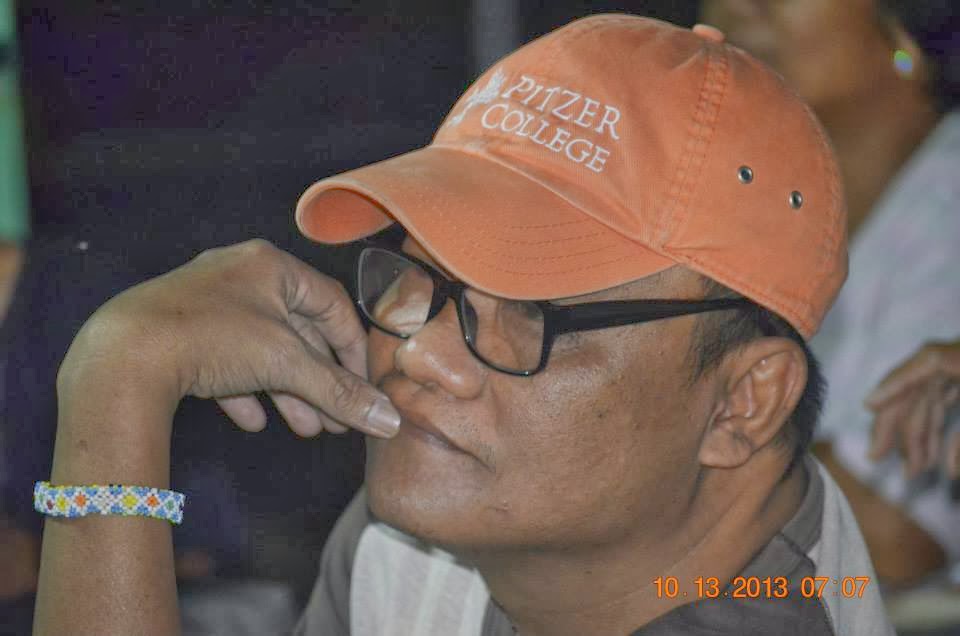January
20 is the feast day of the town’s patron saint, the martyr Sebastian of Gaul. On
its civil side, Sablayan was converted into a full-fledged municipality on
January 04, 1906, under Act No. 1820 of the Philippine Commission according to
some accounts. But its founding year
is a subject of debate among researchers until today because to some, the town
was established earlier in 1902 when Sablayan was separated from Mamburao.
Nonetheless, 1902 was officially considered by the municipality as per practice
and tradition ultimately became the official founding year of Sablayan.
Many
of its citizens today, whether in their civic or religious roles, could rightly
claim that they have served the town the best that they could. In this
narrative, I considered sharing a bit about Father Ludwig Halász, SVD, and
erstwhile political clans from the 40s to pre-EDSA Sablayan like those in
the pedigree of Paulino G. Legaspi, Loreto V. Urieta, and Leoncio A. Ordenes including
businessman Fraterno T. Mendoza, Sr., and those I will mention in passing. Let
us celebrate their memories and contributions to Sablayan’s faith, governance,
and economy.
Happy
fiesta and blissful 120th founding anniversary to the people who
have roots in Sablayan, here, and in other places. Also to those who left this
municipality due to some inevitable circumstances.
Father
Sablayan
On
Ash Wednesday in 1958, Bishop Wilhelm Duschak, SVD, on a breakfast table, told
Father Ludwig Halász, SVD to proceed to Sablayan and
be the parish priest there. Father Halász has been considered as one of the
most loved missionaries assigned there. When he was parish priest, and because
of his influence and over his pastoral guidance through the years, many young
men from his faith community enrolled in the seminary and entered the priesthood.
There are many of them. One of them is the diocesan Fr. Ruben “Jun” Villanueva
of Sta. Lucia, my former director at Social Action Center of the Vicariate, Fr. Florante Gallardo and Fr. Arnel Belamide, among others.
Including the other Sablayan-born and/or raised SVD priests such as Eliseo “Ely”
Yyance, Paulino “King” Belamide, Conrad Alvarez, the dentist-priest Ronillo B. Ordenes, and Limneo “Lim” Dangupon, to
mention just five.
In
his write-up, which appeared in the Souvenir Program for 50th Anniversary of
the Canonical Erection (Don’t laugh. Yes, in church’s parlance, “erection” is
more correct than “construction”!) of San Sebastian Parish (1953-2003), Fr. Halász,
wrote that he did not know Sablayan was when he accepted the appointment,
realizing the challenges ahead of him. Coming from Calapan, the missionary from
Hungary proceeded first to Manila, and on the Feast of the Good Shepherd, he
sailed to Sablayan aboard a lantsa daring
the hostile South China Sea. He reached Sablayan together with the inmates and
employees of the Sablayan Penal Colony (SPC). Records of the SPPF show that the first colonists and employees arrived
in Sablayan on January 15, 1955.
According to the SVD Catalogus published in 1975,
Fr. Halász arrived in the Philippines in 1954 and received his first assignment
as an Assistant Parish Priest in Naujan. In 1955, he moved to the parish in San
Teodoro, to substitute for a priest who went for home vacation. In 1956 he was
assigned to Calapan.
The Catholic missionary remembers, “After lunch, I boarded the Colony’s truck
again and, under the heat of the sun, was brought again to the shore where we
first landed and took a small boat in the direction of the town. Small children
guided me to the convent. Fr. Albert Cook, SVD, awakened from his nap, heartily
and brotherly welcomed me. After he has read my appointment apparently as the
in-coming parish priest, he said, “Good, I know, I told the Bishop that I could
no longer remain in this post. I have to work somewhere else, where I am
needed.” From his words, I felt that the hard works and loneliness await me,
with only a motorboat as a connection with my Society brothers.” Fr. Halász, born in Egyed,
Hungary on July 6, 1927, was ordained a priest on September 20, 1952, was alone
for many years in his work as a missionary in Sablayan.
Under
his pastoral and administrative care, additional chapels in the barrios and
school buildings were built, including the Catholic school known today as the
Colegio de San Sebastian or CDSS. The many chapels that the good priest built
are still serviceable to date. He also revived an abandoned hospital and it is
now known as St. Martin’s Hospital, managed by the Dominican Sisters of Siena,
the only private hospital in town.
The
most-loved priest teamed up with the local government in many social projects
aimed at improving the living condition of the people in this part of the
province.
In
1978, he was transferred to Victoria to be the Parish Priest there. In 1983, he
was reassigned to Sablayan but in 1994 he returned home to Hungary to
strengthen the declining personnel of the Hungarian Province. Fr. Halász died
on April 13, 2015. In his memory, the grateful people of Sablayan put up a
life-size statue of the missionary, whom we AVSJ lay workers used to call
“Father Sablayan”, in front of the parish convent.
Political
forerunners
Rodolfo
M. Acebes’ 2008 book “Mindoro sa Panahon
ng Digmaan 1941 - 1945” (pp. 90 –
93) described vividly how guerilla-turned bandits killed Minoy (Papa)
over unfounded allegations that the former mayor was a Japanese collaborator.
Also killed was Pedring, brother-in-law of Minoy, and Minoy’s brother Pepito.
It was raining hard that night when the freedom fighters turned cattle rustlers
abducted the three men. They were hogtied, stabbed, and hacked to death inside
the municipal building in Poblacion. The three men were buried by their widows
in a shallow grave in the middle of the typhoon the following morning.
Pedro
Gonzales was the mayor of Sablayan when the war broke out. He was only serving
for 11 months when it started. Gonzales was also tortured by the Japanese in
Sablayan Elementary School turned by the invading forces into a garrison. After
being tormented, Gonzales and the rest of his companions were brought to the
sugar mill in Central, Pandurucan (San Jose). Gonzales was tied upside-down
with Vicente Gatchalian, the municipal treasurer, and Generoso Madrigal, the
town’s postmaster.
Lorenzo
“Lory” Ordenes recalled that 9 Sablayan municipal presidents served during the
American colonial period from 1907 to 1940 without a vice-president. It was
only in 1941 when Andres Dantayana became Pedro Gonzales’ vice-president, did
Sablayan elect one into office. Gonzales and Dantayana both served for 6 years.
They were in office during the Japanese Occupation of 1942 to 1945, until a
year after the Philippines was liberated by the Americans in 1946.
The
designations were changed to mayor and vice-mayor respectively in 1948.
Dantayana’s younger brother, Juan, held the office as Sablayan’s first
vice-mayor. He served under Mayor Paulino G. Legaspi until 1951. The Dantayana
brothers hold the distinction of being the first vice-president and the first
vice-mayor of Sablayan. They are also the only brothers in the esteemed roster
of Sablayan municipal leaders, Tito
Lory told me.
Although
not formally trained as a lawyer, Juan Dantayana helped represent Sablayeños in
court, says Ordenes. Dantayana was also the town’s lone notary. Back then,
non-lawyers were still allowed to act as attorneys and perform notarial
services. Ordenes was already a teenager then so he remembers it well.
While
the Dantayanas are the only brothers on the list, husband and wife Leoncio A.
Ordenes and Anastacia O. Ordenes are the only couple to serve as municipal
mayor and vice-mayor of Sablayan, respectively.
In
1959, then-mayor Loreto V. Urieta ran for provincial board member resulting in
Raymundo Gallimbas, his vice-mayor, succeeding him to office. Back then, an
incumbent public official had to resign from his position when he ran for
another post. When Gallimbas became mayor, Anastacia O. Ordenes, who was the
number one elected municipal councilor, assumed the vacated office, as required
by the rules. Anastacia Silva Omañada-Ordenes, or Lola Tasing to most, was born in Sablayan, Occidental Mindoro on
April 15, 1914. She went to Kawit, Cavite for her elementary education and
moved back to Sablayan to pursue her studies.
Tasing
was the first and only woman to serve as Sablayan’s vice-mayor, which she did
for a brief period from 1959 to 1960. Her public service as an elected official
ended when her husband, Leoncio Ordenes Sr, decided to run for and was elected
as mayor in the local election the same year, according to Lorenzo Ordenes, the
late Mayor Leoncio’s youngest son.
Although
Tasing was twice elected as the municipality's number one councilor, she wasn't
the first woman to get this distinction. That honor belongs to her bosom friend
and relative, Francisca de Jesus Salvo or Lola
Kika, the wife of school principal Casiano Salvo. Lola Tasing was the younger sister of Don Lucas Silva Fernandez,
who also served as Sablayan mayor before the Second World War. On the 25th
founding anniversary of the province in 1975, Lola Tasing was awarded Best Parent of Occidental Mindoro bestowed
by Governor Arsenio Villaroza.
The
union between Leoncio and Tasing produced 9 children: the eldest Leovigildo or
Luving was the Postmaster in Sablayan. Leogardo or Garding was a teacher who
later worked at the Bureau of Internal Revenue. Limneo or Lim was the
Provincial Treasurer of Occidental Mindoro. Leonides or Ned worked at the
Health Department Manila. Leandro or Boy was the Division Chief at the
Professional Regulation Commission in Manila. Leonor or Nene, the elder between
two daughters, worked at the Office of the Municipal Assessor in Sablayan.
Leoncio Jr or Impe was a Forest Ranger with the Department of Environment and
Natural Resources office in Sablayan. Lucille or Lucy is a retired public
school teacher. Lorenzo or Lory, who worked at the DENR is the youngest.
Mayor
Leoncio A. Ordenes’s vice-mayor, Floresto Cariaga Sr, had the unique experience
of having the shortest term in said office. Cariaga was mayor for 45 days to
serve out the remaining term of Mayor Ordenes who was unfortunately felled by
an assailant while in office.
There
are also father-and-son tandems on the list. Paulino G. Legaspi was mayor from
1948 to 1951 while his son Rockefeller (or Rocky) served as vice-mayor from
1979 to 1986. Rocky Legaspi was born on July 2, 1937, in Sablayan and
married to the academician Helen Oriondo was blessed to have 6 children. He
graduated in 1960 from Feati University with a Degree in Education Management
(DEM) and AB (Liberal Arts). At the age of 26, Rocky dived into politics in
various capacities as vice-mayor and municipal and provincial legislator, from
1963 until he succumbed to a lingering illness at the age of 79 on March 18,
2016. Rocky is the father of now sitting Sangguniang
Bayan Mark Anthony “McKing” O. Legaspi. McKing’s siblings are Mary Jane,
Eric, Mary Ann, Mary Ellen, and Joseph. He was once an appointed provincial
board member replacing his late father who died in office.
Loreto
V. Urieta was the town leader from 1952 to 1959, and again from 1964 to 1971.
His son Felipe was in turn vice-mayor from 1992 to 1995, and also 1998 to 2001.
Policarpio Urieta, who was municipal president from 1919 to 1921, was Loreto’s
uncle and Felipe’s grand-uncle. He is
the 5th child of Presentacion “Presing” Costa Bundang (the famous
Presing Park was named after her) and Mayor Loreto Villiones Urieta. Felipe’s
father was said to be his role model when it comes to serving people, this is
the reason why Philip followed the footsteps of his grandfather and father.
Felipe’s son, Kristofferson or Bong, the fourth generation of their political
lineage, is an incumbent member of the municipal council.
Means
of transportation in the 50s and 60s are motorboats or sailboats. During the
rainy season, even such means of transport are either dangerous or unavailable
because the waves whipped up by the southwest monsoon are unsafe to small
craft.
During
the dry season, jeeps and trucks are the primary transport. Some travel by foot
or horseback or ride a carabao. Occidental Mindoro’s very own political
scientist Remegio E. Agpalo who hails from Mamburao wrote in his book “The
Political Elite and the People; A Study of Politics in Occidental Mindoro” (pp.
54 – 55) that Sablayan had no electricity in 1965. He also wrote that “Despite
its larger population, on the whole, Sablayan is more underdeveloped
economically than Mamburao.” From
1964 to 1965, the income of Sablayan is pegged at Php 40,495.14. In short,
Sablayan, since the beginning should have been the capital town of the province.
Merchant
from Paetan
It
was in 1959 when Fraterno Torreliza Mendoza, Sr. first set foot on the shores
of Sablayan, specifically in the Barrio of Paetan where he worked as a farmer,
fisherman, and transporter of goods using his small boat. He even sold clothes
from one house to another in the neighborhood. He is a true-blooded merchant no
doubt like his father who was originally from Batangas.
Later,
he moved to the town proper together with his wife Evelyn Vicente Torreliza and
three children, Fraterno Jr., Maria Cristy (now Dimayacyac), and Nerea (now
Tuazon). The Mendozas established a small store and it was the beginning of all
their all successful business ventures today, according to his son, Fraterno
Mendoza, Jr. commonly known to his friends as “Jun Frats”. Well admired by the
progressing town’s early inhabitants and settlers, he was able to gain
prominence as the leading pioneer of local business in the then progressing
municipality.
He
lived a simple life and drawing lessons from his experiences before as a lowly
sales boy, messenger, and vendor in his place of birth and elsewhere, he was
able to master the trade. Though only a college undergraduate, he was able to
surpass the hardships and hurdles of all his businesses. Reserved, thrifty, and
living a simple life, he was able to get properties and his businesses grew.
Mr. Mendoza, needless to say, was an expert in financial management.
Born
in September 29, 1928 in a poor family in Agkawayan, Looc in Lubang Island, he
was raised by his parents Generoso Mendoza of Lipa, Batangas and Dionista
Torreliza, a native of Agkawayan. Mr. Mendoza breathed his last at the age of
86 on December 17, 2014, leaving behind his legacy of being a trailblazer in
local entrepreneurship in this town. He is the epitome of a businessman who has
a heart for working with the town officials during his days. His children now
own various enterprises in town and are one of the most successful local
businessmen in Sablayan.
As
a private individual, he was able to win the hearts of his coterie of friends
and business partners. In Sablayan, whoever becomes the mayor, greatly
considered Mr. Mendoza, in a way, as an innovative advocate and model of local
entrepreneurship towards its development mission and goals. With all these
legacies, the patriarch placed himself significantly in the economic and
historical context of Sablayan and was perceived as someone who has contributed
to the positive development of local pride through a good example shown by his
name.
Niche
I
worked in Sablayan until I found my niche and as I write this, I constantly
remind myself that I am not alone. I am surrounded by a great host of friendly
and beautiful people, past and present. Especially those who love to share the
town’s history who are so generous with their time and memories. Special to mention
Mr. Lory Ordenes and those who are lucky enough to live with the town’s
pioneers.
This
essay is unreservedly dedicated to the people of Sablayan, past, present, and
those still yet to be born and to the loving memory of the long-gone men and
women including those who are still with us today and still active in their
different fields, be it as civil servants or in the priestly ministry, or
otherwise, in every part of the world.
I
have a deep affinity for Sablayan - it's a second home to me and those who come
before me – its people treat us like we are their own.
------
(The
undated photo above is courtesy of Lory Ordenes showing President Diosdado
Macapagal, Fr. Ludwig “Luis” Halász, SVD, Gov. Arsenio Villaroza along with Mayor
Loreto V. Urieta and his wife Presentacion Bundang-Urieta, Diosdado Gozar,
Councilor Anastasia Ordenes, Diosdado Gozar and his wife Lolita Gozar with
Vice-Mayor Martin Pacheco and Ms. Florence Valentin and some prominent
residents on the inauguration of Rural Heath Center in Poblacion.)










